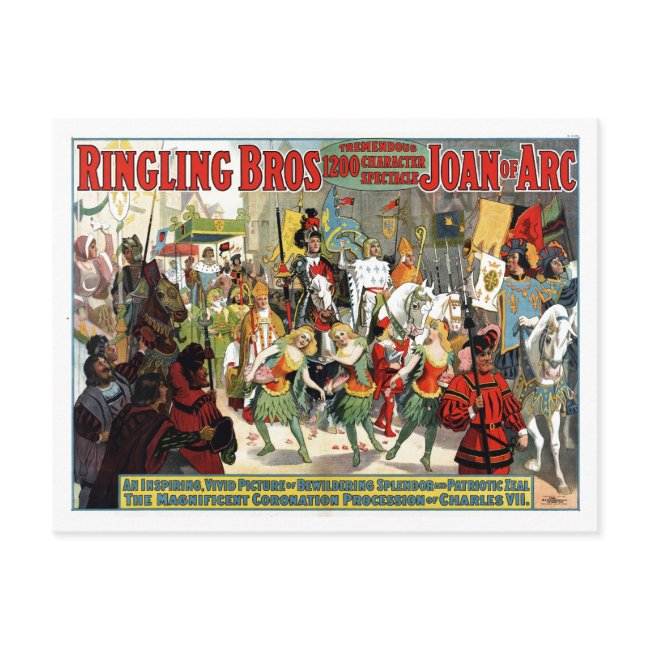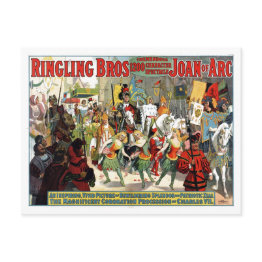Ringling Brothers Circus Joan Of Arc Spectacular Postinvitations
$1.65 per Invitation
Get it for only $$0.99 per invitation Learn How
Get 40% Off
You can save as much as 50% on your invitations
| Order | Save | New Price |
|---|---|---|
| 25+ Invitations | 15% | $$1.40 Per Invitation ($$0.25 Off) |
| 50+ Invitations | 25% | $$1.24 Per Invitation ($$0.41 Off) |
| 100+ Invitations | 40% | $$0.99 Per Invitation ($$0.66 Off) |
| 250+ Invitations | 45% | $$0.91 Per Invitation ($$0.74 Off) |
| 1000+ Invitations | 50% | $$0.83 Per Invitation ($$0.83 Off) |
tremendous 1200 character spectacle Joan of Arc--An inspiring, vivid picture ... the magnificent coronation of Charles VII Charles--VII,--King of France,--1403-1461--Portrayals. ;Joan,--of Arc, Saint,--1412-1431--Portrayals. ;Ringling Brothers--Performances--1910-1920. ;Parades & processions--1910-1920. ;Circuses & shows--1910-1920. The Ringling brothers were seven siblings who transformed their small touring company of performers into one of America's largest circuses in the late 19th and early 20th centuries. Born in McGregor, Iowa and raised in Baraboo, Wisconsin, they were the children of Heinrich Friedrich August Ringling (1826-1898) of Hanover, Germany and Marie Salome Juliar (1833-1907) of Ostheim, France. They merged their Ringling Brothers Circus with America's other leading circus troupes, ultimately creating the Ringling Bros. and Barnum & Bailey Circus, which still tours today under their name. Ringling Bros. and Barnum & Bailey Circus was started when the circus created by James Anthony Bailey and P. T. Barnum was merged with the Ringling Brothers Circus. The Ringling brothers purchased the Barnum & Bailey Circus in 1907, but ran the circuses separately until they were finally merged in 1919. Saint Joan of Arc or The Maid of Orléans (French: Jeanne d'Arc; ca. 1412 – 30 May 1431) is a national heroine of France and a Catholic saint. A peasant girl born in eastern France, she led the French army to several important victories during the Hundred Years' War, claiming divine guidance, and was indirectly responsible for the coronation of Charles VII. She was captured by the Burgundians, sold to the English, tried by an ecclesiastical court, and burned at the stake when she was nineteen years old. Twenty-four years later, on the initiative of Charles VII, who could not afford being seen as having been brought to power with the aid of a condemned heretic, Pope Callixtus III reviewed the decision of the ecclesiastical court, found her innocent, and declared her a martyr. She was beatified in 1909 and canonized in 1920. She is, along with St. Denis, St. Martin of Tours, St. Louis IX, and St. Theresa of Lisieux, one of the patron saints of France. Joan asserted that she had visions from God that told her to recover her homeland from English domination late in the Hundred Years' War. The uncrowned King Charles VII sent her to the siege at Orléans as part of a relief mission. She gained prominence when she overcame the dismissive attitude of veteran commanders and lifted the siege in only nine days. Several more swift victories led to Charles VII's coronation at Reims and settled the disputed succession to the throne. Joan of Arc has remained an important figure in Western culture. From Napoleon to the present, French politicians of all leanings have invoked her memory. Major writers and composers who have created works about her include Shakespeare (Henry VI, Part 1), Voltaire (La Pucelle d'Orléans), Schiller (Die Jungfrau von Orléans ), Verdi (Giovanna d'Arco), Tchaikovsky (Орлеанская дева), Mark Twain (Personal Recollections of Joan of Arc), Jean Anouilh (L'Alouette), Bertolt Brecht (Die heilige Johanna der Schlachthöfe), George Bernard Shaw (Saint Joan), and Maxwell Anderson (Joan of Lorraine). Depictions of her continue in film, television, video games, song, and dance.










